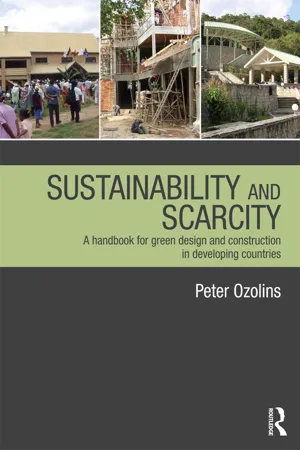
Sustainability & Scarcity
A Handbook for Green Design and Construction in Developing Countries
- 226 pages
- English
- ePUB (mobile friendly)
- Available on iOS & Android
Sustainability & Scarcity
A Handbook for Green Design and Construction in Developing Countries
About this book
Sustainability & Scarcity addresses a gap in the literature on green building recognized by many in the fields of international development, architecture, construction, housing and sustainability. Rather than being based on the experiences of more economically-developed countries, this book describes the nature of green building in the developing world, elaborating the main issues that define sustainability in those particular contexts.
Through more than 30 years of development work in design and construction in Africa and the Middle East, the author has seen well-intentioned development projects, both in theory and in practice, that ultimately do not contribute to sustainable development. Starting from the basis of green building rating tools used in the more economically-developed countries, the author draws from his own experiences to make available to other practitioners green building strategies relevant to the developing country context that promise effective solutions to their need for sustainable green design.
The book looks in detail at examples of buildings in Tanzania, Madagascar, Nepal, Haiti, and Vietnam, illustrating the application of the green building strategies described. Fully illustrated with drawings and full colour photos, the book is a practical guide for practitioners and policy-makers working in the poorest regions of the world. Sustainability & Scarcity is quite simply an essential handbook for anyone concerned with sustainable design and building in the developing world.
Frequently asked questions
- Essential is ideal for learners and professionals who enjoy exploring a wide range of subjects. Access the Essential Library with 800,000+ trusted titles and best-sellers across business, personal growth, and the humanities. Includes unlimited reading time and Standard Read Aloud voice.
- Complete: Perfect for advanced learners and researchers needing full, unrestricted access. Unlock 1.4M+ books across hundreds of subjects, including academic and specialized titles. The Complete Plan also includes advanced features like Premium Read Aloud and Research Assistant.
Please note we cannot support devices running on iOS 13 and Android 7 or earlier. Learn more about using the app.
Information
PART 1
BIG PICTURE: GREEN BUILDINGS AND LEAST
DEVELOPED REGIONS
Chapter 1: Green building and the Least Developed Regions
SUSTAINABILITY AND GREEN BUILDING
sustainable development means integrating the economic, social and environmental objectives of society, in order to maximize human well-being in the present without compromising the ability of future generations to meet their needs.3
– Economic growth for more prosperity– Equal opportunities for rich and poor, North and South, men and women– Natural resource use for the benefit of present and future generations.4
– expanding economic opportunities (especially for poor people);– meeting basic human needs (food, clean water, shelter, health care, education and fulfillment of the human spirit);– protecting and enhancing the environment; and– promoting pluralism and democratic participation (especially by poor people).5
First … a setof concepts that help explain social action, the relationships among people, their complex forms of social organization, their institutionalized arrangements, and the culture, motives, stimuli, and values that regulate their behavior vis-à-vis one another and natural resources. Second … it offers a set of social techniques apt to prompt coordinated social action, inhibit detrimental behavior, foster association, craft alternative social arrangements, and develop social capital.6
as a complex set of interacting cultural and institutional systems that vary from one place to another. All have bodies of knowledge for adapting to the physical environment; modes of producing and exchanging goods and services; systems for finding partners, raising children, and inheriting property; arrangements for public decision making and conflict management; bodies of belief and related rituals; and systems of prestige or ranking, and aesthetics. From the outside the complexity and dynamism of these interacting systems are mind boggling. Viewed from the inside by the people who constitute a society, they fit together in a sensible and seamless way, and individuals' attitudes and behaviours reflect the values and pressures that they have internalized while growing up.7

Table of contents
- Cover Page
- Half Title page
- Title Page
- Copyright Page
- Dedication
- Acknowledgements
- Contents
- List of Figures
- Preface
- Introduction
- Part 1 Big Picture: Green Buildings and Least Developed Regions
- Part 2 Green Buildings and Least Developed Regions in Detail
- Part 3 Components of Green Building in the Least Developed Regions
- Part 4 Case Studies: Tanzania, Madagascar, Haiti, Nepal and Vietnam
- Index